Analysis of Tesla's People and Organization: A Comprehensive Report
VerifiedAdded on 2023/01/13
|12
|3616
|73
Report
AI Summary
This report provides a comprehensive analysis of Tesla's people and organization. It begins with an introduction to organizational structures and then delves into the impact of globalization on Tesla's operations, highlighting how it has facilitated market expansion and reduced costs. The report examines Tesla's culture, power dynamics, and leadership style, particularly focusing on Elon Musk's democratic approach. It also discusses motivation and job design strategies employed by Tesla. The second part of the report offers a reflective analysis of group work, using Kolb's learning cycle to illustrate the team's dynamics, communication strategies, and the division of responsibilities. The final section presents a personal reflection on employment, drawing insights from the module on people and organization. The report concludes with a summary of key findings and references.
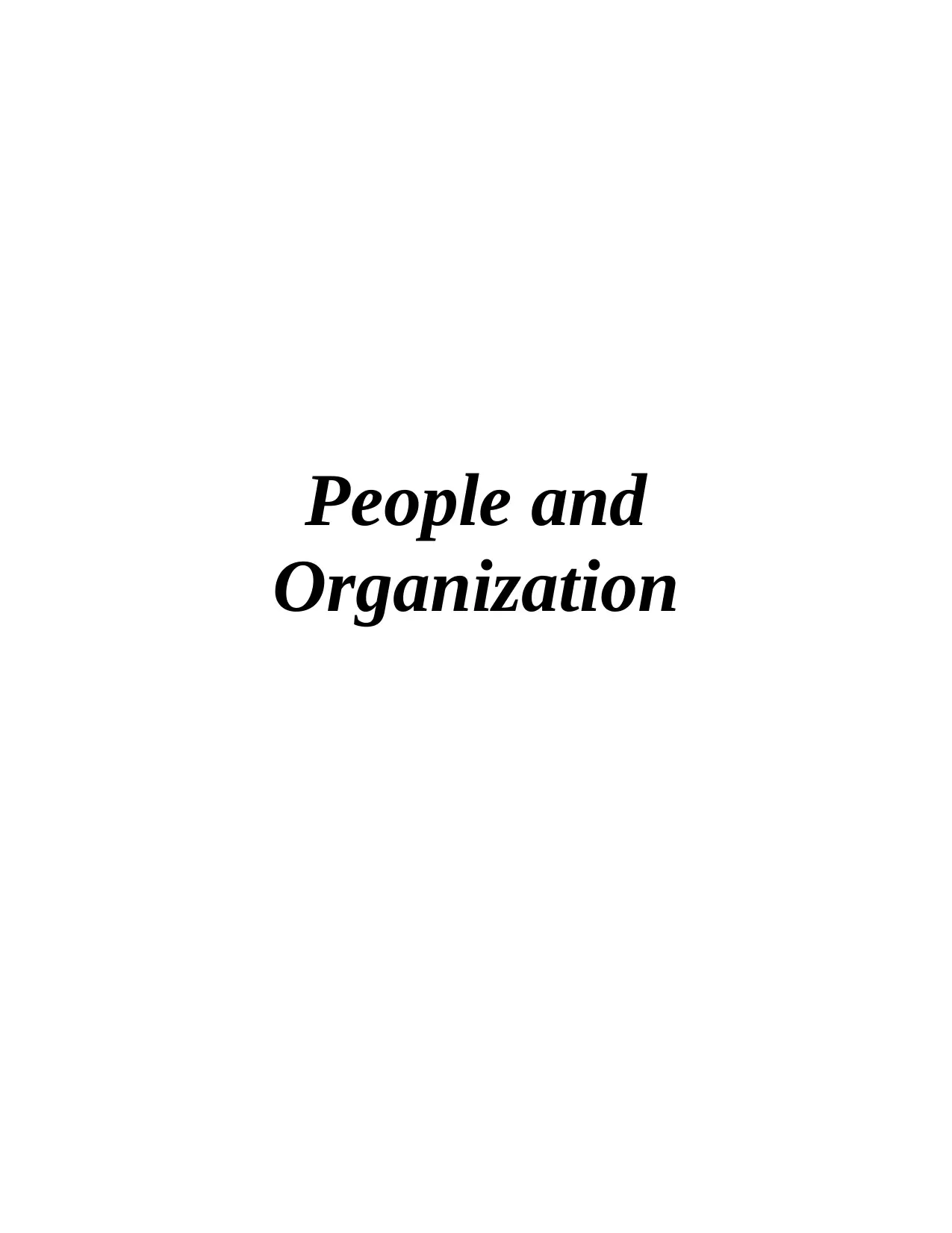
People and
Organization
Organization
Paraphrase This Document
Need a fresh take? Get an instant paraphrase of this document with our AI Paraphraser
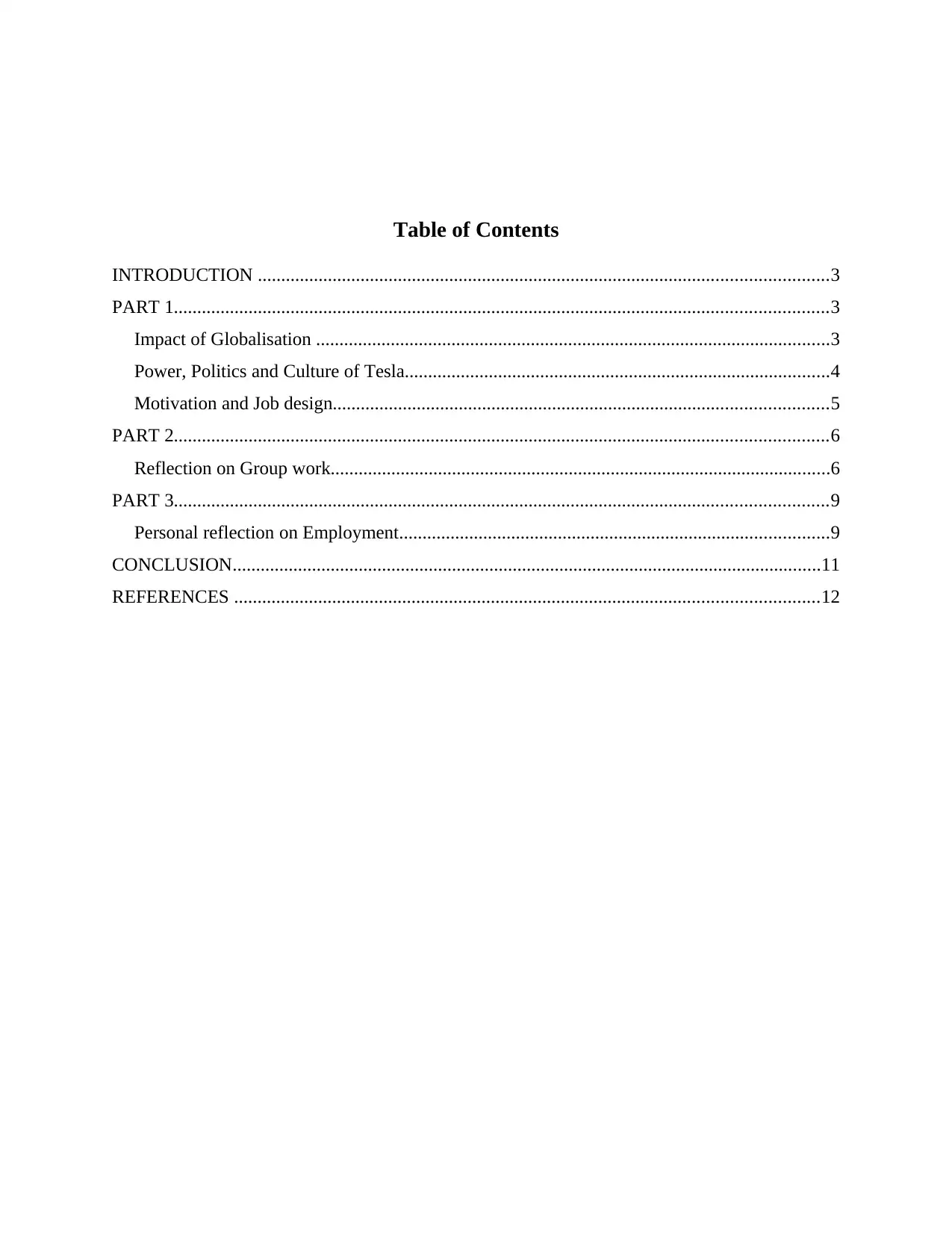
Table of Contents
INTRODUCTION ..........................................................................................................................3
PART 1............................................................................................................................................3
Impact of Globalisation ..............................................................................................................3
Power, Politics and Culture of Tesla...........................................................................................4
Motivation and Job design..........................................................................................................5
PART 2............................................................................................................................................6
Reflection on Group work...........................................................................................................6
PART 3............................................................................................................................................9
Personal reflection on Employment............................................................................................9
CONCLUSION..............................................................................................................................11
REFERENCES .............................................................................................................................12
INTRODUCTION ..........................................................................................................................3
PART 1............................................................................................................................................3
Impact of Globalisation ..............................................................................................................3
Power, Politics and Culture of Tesla...........................................................................................4
Motivation and Job design..........................................................................................................5
PART 2............................................................................................................................................6
Reflection on Group work...........................................................................................................6
PART 3............................................................................................................................................9
Personal reflection on Employment............................................................................................9
CONCLUSION..............................................................................................................................11
REFERENCES .............................................................................................................................12
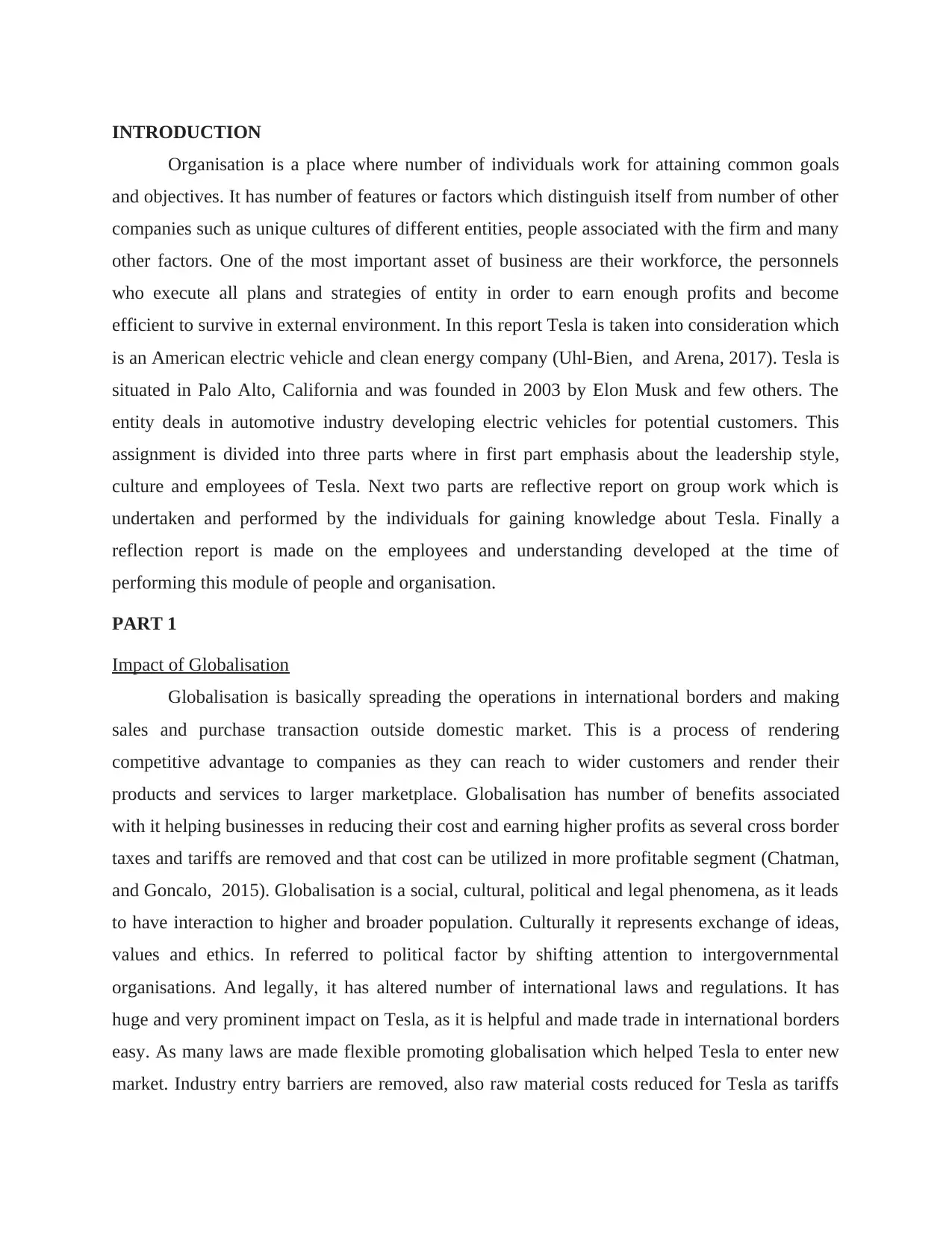
INTRODUCTION
Organisation is a place where number of individuals work for attaining common goals
and objectives. It has number of features or factors which distinguish itself from number of other
companies such as unique cultures of different entities, people associated with the firm and many
other factors. One of the most important asset of business are their workforce, the personnels
who execute all plans and strategies of entity in order to earn enough profits and become
efficient to survive in external environment. In this report Tesla is taken into consideration which
is an American electric vehicle and clean energy company (Uhl-Bien, and Arena, 2017). Tesla is
situated in Palo Alto, California and was founded in 2003 by Elon Musk and few others. The
entity deals in automotive industry developing electric vehicles for potential customers. This
assignment is divided into three parts where in first part emphasis about the leadership style,
culture and employees of Tesla. Next two parts are reflective report on group work which is
undertaken and performed by the individuals for gaining knowledge about Tesla. Finally a
reflection report is made on the employees and understanding developed at the time of
performing this module of people and organisation.
PART 1
Impact of Globalisation
Globalisation is basically spreading the operations in international borders and making
sales and purchase transaction outside domestic market. This is a process of rendering
competitive advantage to companies as they can reach to wider customers and render their
products and services to larger marketplace. Globalisation has number of benefits associated
with it helping businesses in reducing their cost and earning higher profits as several cross border
taxes and tariffs are removed and that cost can be utilized in more profitable segment (Chatman,
and Goncalo, 2015). Globalisation is a social, cultural, political and legal phenomena, as it leads
to have interaction to higher and broader population. Culturally it represents exchange of ideas,
values and ethics. In referred to political factor by shifting attention to intergovernmental
organisations. And legally, it has altered number of international laws and regulations. It has
huge and very prominent impact on Tesla, as it is helpful and made trade in international borders
easy. As many laws are made flexible promoting globalisation which helped Tesla to enter new
market. Industry entry barriers are removed, also raw material costs reduced for Tesla as tariffs
Organisation is a place where number of individuals work for attaining common goals
and objectives. It has number of features or factors which distinguish itself from number of other
companies such as unique cultures of different entities, people associated with the firm and many
other factors. One of the most important asset of business are their workforce, the personnels
who execute all plans and strategies of entity in order to earn enough profits and become
efficient to survive in external environment. In this report Tesla is taken into consideration which
is an American electric vehicle and clean energy company (Uhl-Bien, and Arena, 2017). Tesla is
situated in Palo Alto, California and was founded in 2003 by Elon Musk and few others. The
entity deals in automotive industry developing electric vehicles for potential customers. This
assignment is divided into three parts where in first part emphasis about the leadership style,
culture and employees of Tesla. Next two parts are reflective report on group work which is
undertaken and performed by the individuals for gaining knowledge about Tesla. Finally a
reflection report is made on the employees and understanding developed at the time of
performing this module of people and organisation.
PART 1
Impact of Globalisation
Globalisation is basically spreading the operations in international borders and making
sales and purchase transaction outside domestic market. This is a process of rendering
competitive advantage to companies as they can reach to wider customers and render their
products and services to larger marketplace. Globalisation has number of benefits associated
with it helping businesses in reducing their cost and earning higher profits as several cross border
taxes and tariffs are removed and that cost can be utilized in more profitable segment (Chatman,
and Goncalo, 2015). Globalisation is a social, cultural, political and legal phenomena, as it leads
to have interaction to higher and broader population. Culturally it represents exchange of ideas,
values and ethics. In referred to political factor by shifting attention to intergovernmental
organisations. And legally, it has altered number of international laws and regulations. It has
huge and very prominent impact on Tesla, as it is helpful and made trade in international borders
easy. As many laws are made flexible promoting globalisation which helped Tesla to enter new
market. Industry entry barriers are removed, also raw material costs reduced for Tesla as tariffs
⊘ This is a preview!⊘
Do you want full access?
Subscribe today to unlock all pages.

Trusted by 1+ million students worldwide
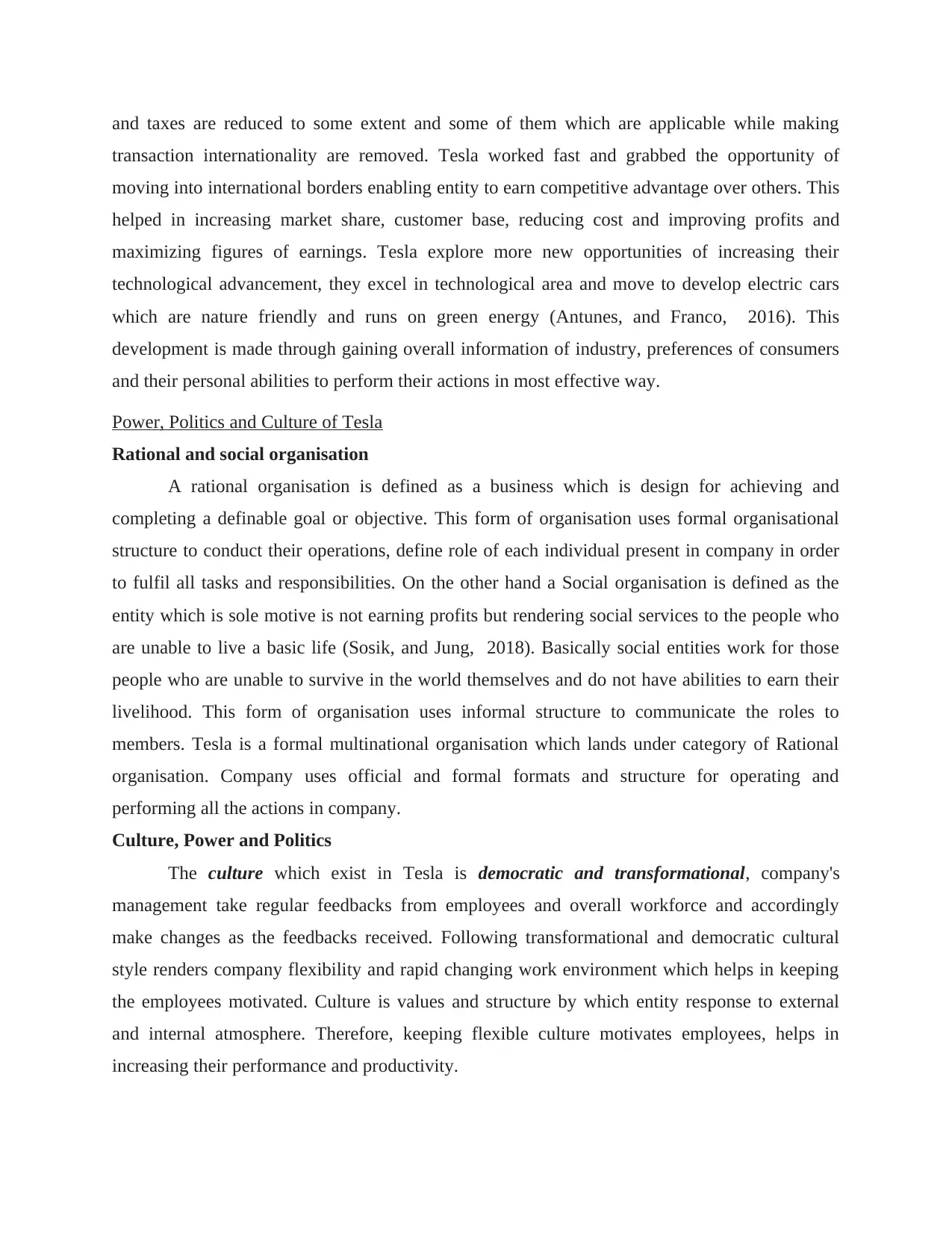
and taxes are reduced to some extent and some of them which are applicable while making
transaction internationality are removed. Tesla worked fast and grabbed the opportunity of
moving into international borders enabling entity to earn competitive advantage over others. This
helped in increasing market share, customer base, reducing cost and improving profits and
maximizing figures of earnings. Tesla explore more new opportunities of increasing their
technological advancement, they excel in technological area and move to develop electric cars
which are nature friendly and runs on green energy (Antunes, and Franco, 2016). This
development is made through gaining overall information of industry, preferences of consumers
and their personal abilities to perform their actions in most effective way.
Power, Politics and Culture of Tesla
Rational and social organisation
A rational organisation is defined as a business which is design for achieving and
completing a definable goal or objective. This form of organisation uses formal organisational
structure to conduct their operations, define role of each individual present in company in order
to fulfil all tasks and responsibilities. On the other hand a Social organisation is defined as the
entity which is sole motive is not earning profits but rendering social services to the people who
are unable to live a basic life (Sosik, and Jung, 2018). Basically social entities work for those
people who are unable to survive in the world themselves and do not have abilities to earn their
livelihood. This form of organisation uses informal structure to communicate the roles to
members. Tesla is a formal multinational organisation which lands under category of Rational
organisation. Company uses official and formal formats and structure for operating and
performing all the actions in company.
Culture, Power and Politics
The culture which exist in Tesla is democratic and transformational, company's
management take regular feedbacks from employees and overall workforce and accordingly
make changes as the feedbacks received. Following transformational and democratic cultural
style renders company flexibility and rapid changing work environment which helps in keeping
the employees motivated. Culture is values and structure by which entity response to external
and internal atmosphere. Therefore, keeping flexible culture motivates employees, helps in
increasing their performance and productivity.
transaction internationality are removed. Tesla worked fast and grabbed the opportunity of
moving into international borders enabling entity to earn competitive advantage over others. This
helped in increasing market share, customer base, reducing cost and improving profits and
maximizing figures of earnings. Tesla explore more new opportunities of increasing their
technological advancement, they excel in technological area and move to develop electric cars
which are nature friendly and runs on green energy (Antunes, and Franco, 2016). This
development is made through gaining overall information of industry, preferences of consumers
and their personal abilities to perform their actions in most effective way.
Power, Politics and Culture of Tesla
Rational and social organisation
A rational organisation is defined as a business which is design for achieving and
completing a definable goal or objective. This form of organisation uses formal organisational
structure to conduct their operations, define role of each individual present in company in order
to fulfil all tasks and responsibilities. On the other hand a Social organisation is defined as the
entity which is sole motive is not earning profits but rendering social services to the people who
are unable to live a basic life (Sosik, and Jung, 2018). Basically social entities work for those
people who are unable to survive in the world themselves and do not have abilities to earn their
livelihood. This form of organisation uses informal structure to communicate the roles to
members. Tesla is a formal multinational organisation which lands under category of Rational
organisation. Company uses official and formal formats and structure for operating and
performing all the actions in company.
Culture, Power and Politics
The culture which exist in Tesla is democratic and transformational, company's
management take regular feedbacks from employees and overall workforce and accordingly
make changes as the feedbacks received. Following transformational and democratic cultural
style renders company flexibility and rapid changing work environment which helps in keeping
the employees motivated. Culture is values and structure by which entity response to external
and internal atmosphere. Therefore, keeping flexible culture motivates employees, helps in
increasing their performance and productivity.
Paraphrase This Document
Need a fresh take? Get an instant paraphrase of this document with our AI Paraphraser
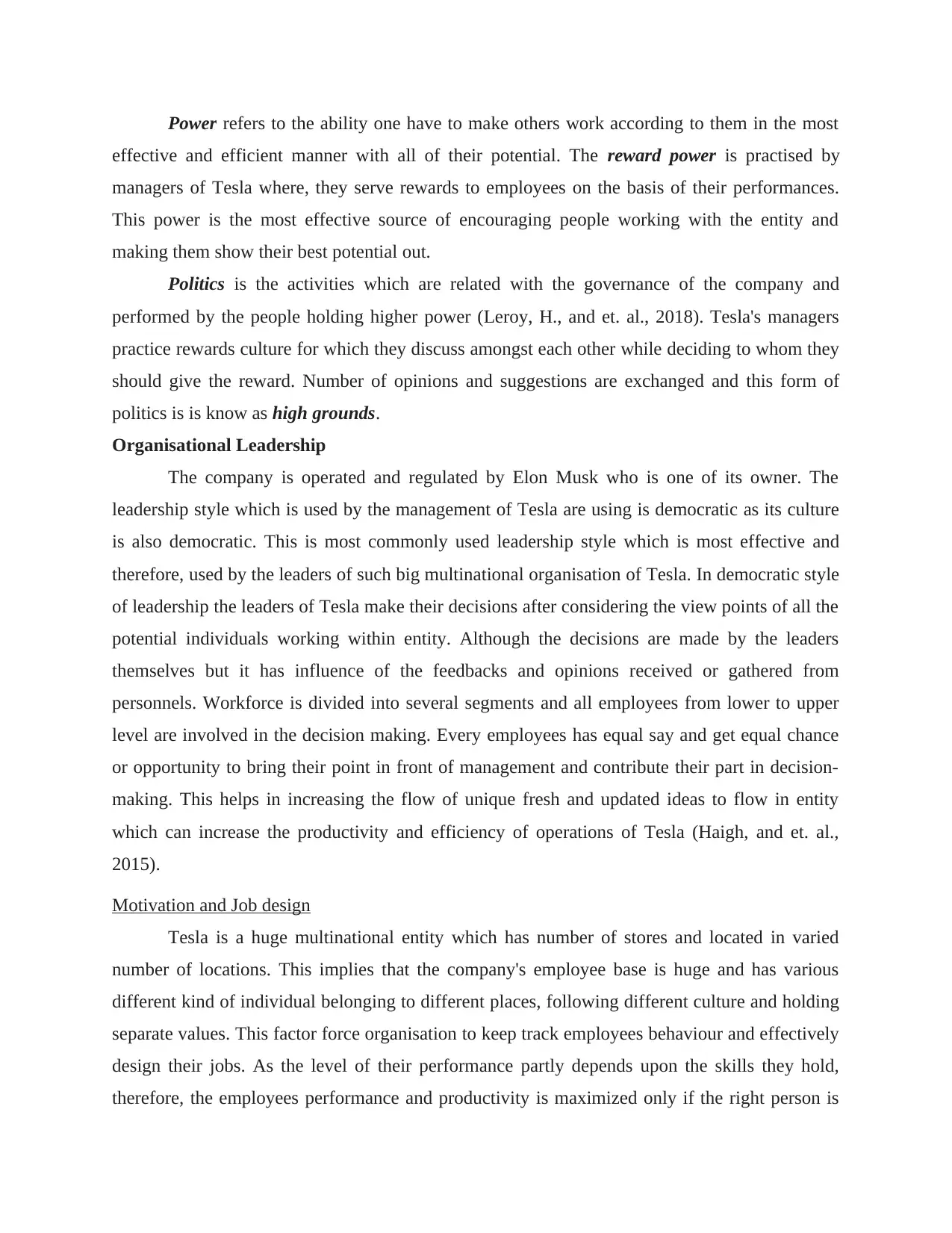
Power refers to the ability one have to make others work according to them in the most
effective and efficient manner with all of their potential. The reward power is practised by
managers of Tesla where, they serve rewards to employees on the basis of their performances.
This power is the most effective source of encouraging people working with the entity and
making them show their best potential out.
Politics is the activities which are related with the governance of the company and
performed by the people holding higher power (Leroy, H., and et. al., 2018). Tesla's managers
practice rewards culture for which they discuss amongst each other while deciding to whom they
should give the reward. Number of opinions and suggestions are exchanged and this form of
politics is is know as high grounds.
Organisational Leadership
The company is operated and regulated by Elon Musk who is one of its owner. The
leadership style which is used by the management of Tesla are using is democratic as its culture
is also democratic. This is most commonly used leadership style which is most effective and
therefore, used by the leaders of such big multinational organisation of Tesla. In democratic style
of leadership the leaders of Tesla make their decisions after considering the view points of all the
potential individuals working within entity. Although the decisions are made by the leaders
themselves but it has influence of the feedbacks and opinions received or gathered from
personnels. Workforce is divided into several segments and all employees from lower to upper
level are involved in the decision making. Every employees has equal say and get equal chance
or opportunity to bring their point in front of management and contribute their part in decision-
making. This helps in increasing the flow of unique fresh and updated ideas to flow in entity
which can increase the productivity and efficiency of operations of Tesla (Haigh, and et. al.,
2015).
Motivation and Job design
Tesla is a huge multinational entity which has number of stores and located in varied
number of locations. This implies that the company's employee base is huge and has various
different kind of individual belonging to different places, following different culture and holding
separate values. This factor force organisation to keep track employees behaviour and effectively
design their jobs. As the level of their performance partly depends upon the skills they hold,
therefore, the employees performance and productivity is maximized only if the right person is
effective and efficient manner with all of their potential. The reward power is practised by
managers of Tesla where, they serve rewards to employees on the basis of their performances.
This power is the most effective source of encouraging people working with the entity and
making them show their best potential out.
Politics is the activities which are related with the governance of the company and
performed by the people holding higher power (Leroy, H., and et. al., 2018). Tesla's managers
practice rewards culture for which they discuss amongst each other while deciding to whom they
should give the reward. Number of opinions and suggestions are exchanged and this form of
politics is is know as high grounds.
Organisational Leadership
The company is operated and regulated by Elon Musk who is one of its owner. The
leadership style which is used by the management of Tesla are using is democratic as its culture
is also democratic. This is most commonly used leadership style which is most effective and
therefore, used by the leaders of such big multinational organisation of Tesla. In democratic style
of leadership the leaders of Tesla make their decisions after considering the view points of all the
potential individuals working within entity. Although the decisions are made by the leaders
themselves but it has influence of the feedbacks and opinions received or gathered from
personnels. Workforce is divided into several segments and all employees from lower to upper
level are involved in the decision making. Every employees has equal say and get equal chance
or opportunity to bring their point in front of management and contribute their part in decision-
making. This helps in increasing the flow of unique fresh and updated ideas to flow in entity
which can increase the productivity and efficiency of operations of Tesla (Haigh, and et. al.,
2015).
Motivation and Job design
Tesla is a huge multinational entity which has number of stores and located in varied
number of locations. This implies that the company's employee base is huge and has various
different kind of individual belonging to different places, following different culture and holding
separate values. This factor force organisation to keep track employees behaviour and effectively
design their jobs. As the level of their performance partly depends upon the skills they hold,
therefore, the employees performance and productivity is maximized only if the right person is
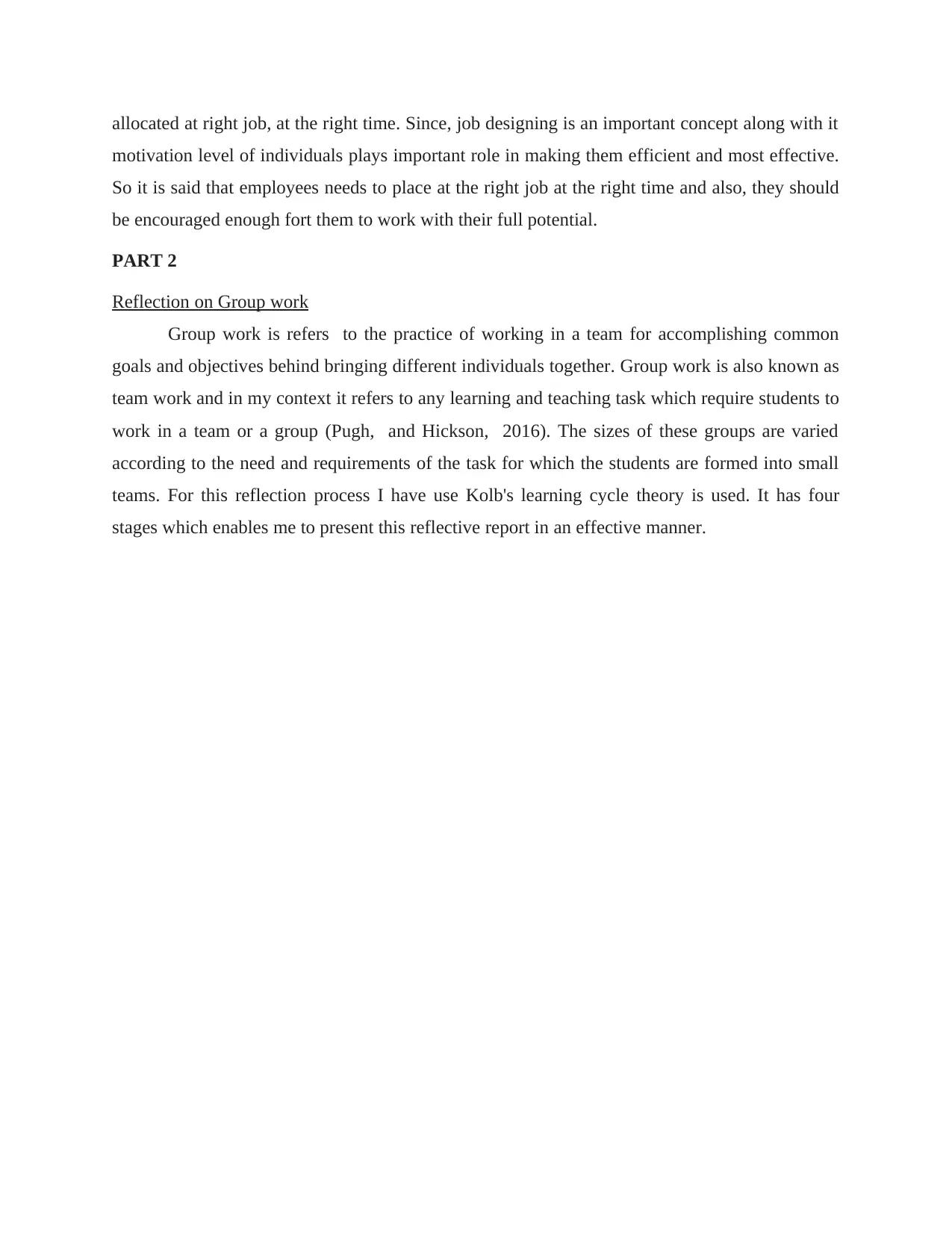
allocated at right job, at the right time. Since, job designing is an important concept along with it
motivation level of individuals plays important role in making them efficient and most effective.
So it is said that employees needs to place at the right job at the right time and also, they should
be encouraged enough fort them to work with their full potential.
PART 2
Reflection on Group work
Group work is refers to the practice of working in a team for accomplishing common
goals and objectives behind bringing different individuals together. Group work is also known as
team work and in my context it refers to any learning and teaching task which require students to
work in a team or a group (Pugh, and Hickson, 2016). The sizes of these groups are varied
according to the need and requirements of the task for which the students are formed into small
teams. For this reflection process I have use Kolb's learning cycle theory is used. It has four
stages which enables me to present this reflective report in an effective manner.
motivation level of individuals plays important role in making them efficient and most effective.
So it is said that employees needs to place at the right job at the right time and also, they should
be encouraged enough fort them to work with their full potential.
PART 2
Reflection on Group work
Group work is refers to the practice of working in a team for accomplishing common
goals and objectives behind bringing different individuals together. Group work is also known as
team work and in my context it refers to any learning and teaching task which require students to
work in a team or a group (Pugh, and Hickson, 2016). The sizes of these groups are varied
according to the need and requirements of the task for which the students are formed into small
teams. For this reflection process I have use Kolb's learning cycle theory is used. It has four
stages which enables me to present this reflective report in an effective manner.
⊘ This is a preview!⊘
Do you want full access?
Subscribe today to unlock all pages.

Trusted by 1+ million students worldwide
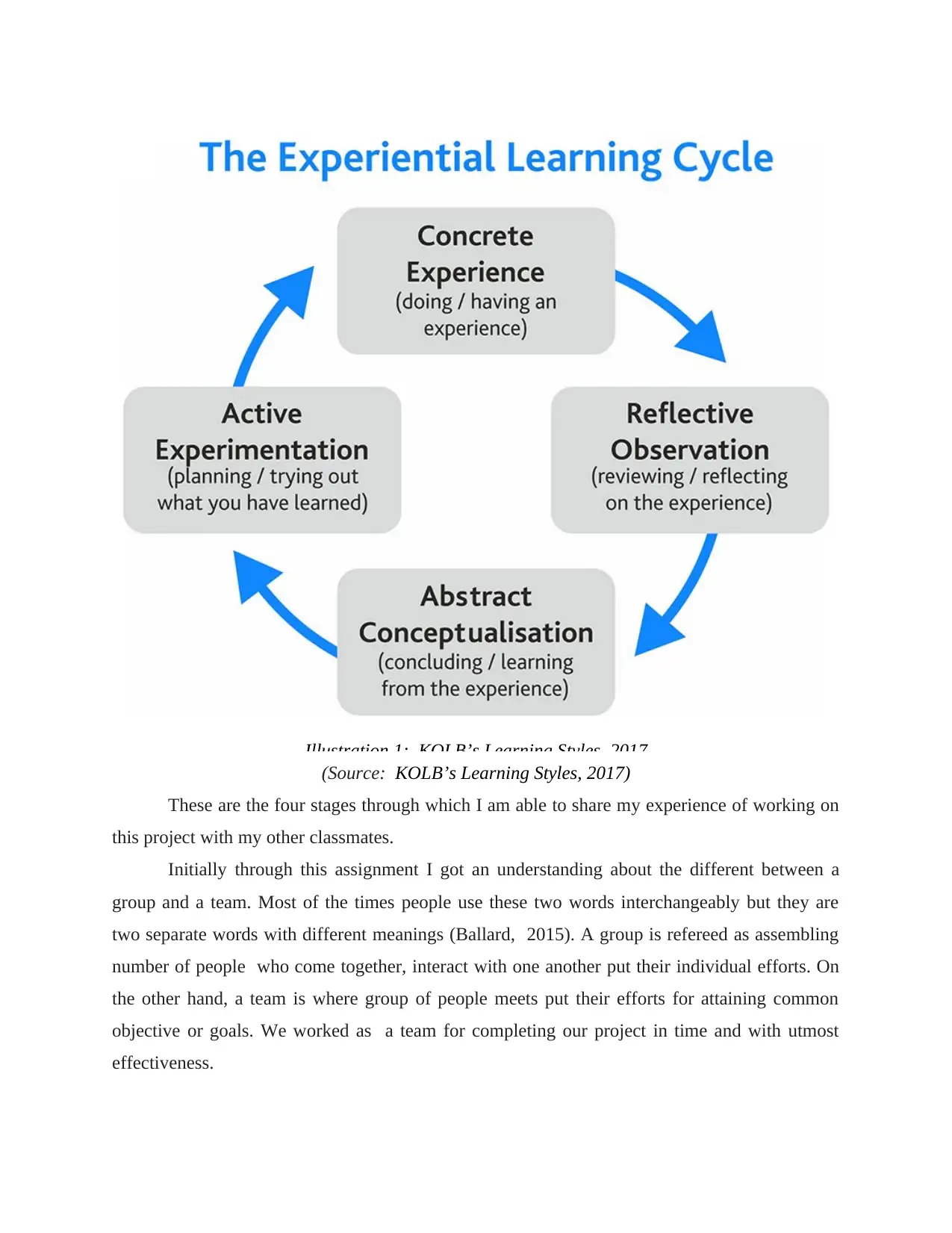
(Source: KOLB’s Learning Styles, 2017)
These are the four stages through which I am able to share my experience of working on
this project with my other classmates.
Initially through this assignment I got an understanding about the different between a
group and a team. Most of the times people use these two words interchangeably but they are
two separate words with different meanings (Ballard, 2015). A group is refereed as assembling
number of people who come together, interact with one another put their individual efforts. On
the other hand, a team is where group of people meets put their efforts for attaining common
objective or goals. We worked as a team for completing our project in time and with utmost
effectiveness.
Illustration 1: KOLB’s Learning Styles, 2017
These are the four stages through which I am able to share my experience of working on
this project with my other classmates.
Initially through this assignment I got an understanding about the different between a
group and a team. Most of the times people use these two words interchangeably but they are
two separate words with different meanings (Ballard, 2015). A group is refereed as assembling
number of people who come together, interact with one another put their individual efforts. On
the other hand, a team is where group of people meets put their efforts for attaining common
objective or goals. We worked as a team for completing our project in time and with utmost
effectiveness.
Illustration 1: KOLB’s Learning Styles, 2017
Paraphrase This Document
Need a fresh take? Get an instant paraphrase of this document with our AI Paraphraser
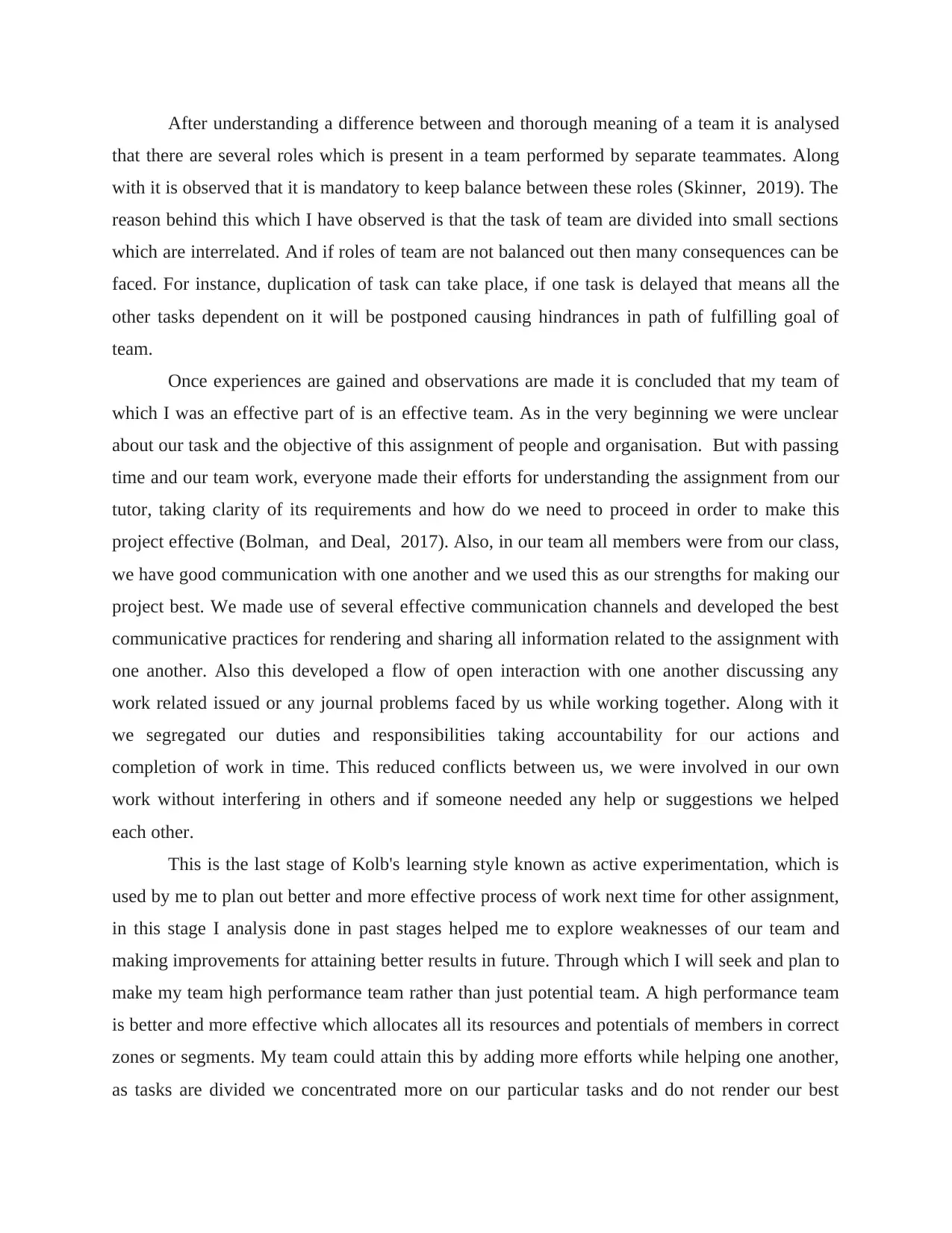
After understanding a difference between and thorough meaning of a team it is analysed
that there are several roles which is present in a team performed by separate teammates. Along
with it is observed that it is mandatory to keep balance between these roles (Skinner, 2019). The
reason behind this which I have observed is that the task of team are divided into small sections
which are interrelated. And if roles of team are not balanced out then many consequences can be
faced. For instance, duplication of task can take place, if one task is delayed that means all the
other tasks dependent on it will be postponed causing hindrances in path of fulfilling goal of
team.
Once experiences are gained and observations are made it is concluded that my team of
which I was an effective part of is an effective team. As in the very beginning we were unclear
about our task and the objective of this assignment of people and organisation. But with passing
time and our team work, everyone made their efforts for understanding the assignment from our
tutor, taking clarity of its requirements and how do we need to proceed in order to make this
project effective (Bolman, and Deal, 2017). Also, in our team all members were from our class,
we have good communication with one another and we used this as our strengths for making our
project best. We made use of several effective communication channels and developed the best
communicative practices for rendering and sharing all information related to the assignment with
one another. Also this developed a flow of open interaction with one another discussing any
work related issued or any journal problems faced by us while working together. Along with it
we segregated our duties and responsibilities taking accountability for our actions and
completion of work in time. This reduced conflicts between us, we were involved in our own
work without interfering in others and if someone needed any help or suggestions we helped
each other.
This is the last stage of Kolb's learning style known as active experimentation, which is
used by me to plan out better and more effective process of work next time for other assignment,
in this stage I analysis done in past stages helped me to explore weaknesses of our team and
making improvements for attaining better results in future. Through which I will seek and plan to
make my team high performance team rather than just potential team. A high performance team
is better and more effective which allocates all its resources and potentials of members in correct
zones or segments. My team could attain this by adding more efforts while helping one another,
as tasks are divided we concentrated more on our particular tasks and do not render our best
that there are several roles which is present in a team performed by separate teammates. Along
with it is observed that it is mandatory to keep balance between these roles (Skinner, 2019). The
reason behind this which I have observed is that the task of team are divided into small sections
which are interrelated. And if roles of team are not balanced out then many consequences can be
faced. For instance, duplication of task can take place, if one task is delayed that means all the
other tasks dependent on it will be postponed causing hindrances in path of fulfilling goal of
team.
Once experiences are gained and observations are made it is concluded that my team of
which I was an effective part of is an effective team. As in the very beginning we were unclear
about our task and the objective of this assignment of people and organisation. But with passing
time and our team work, everyone made their efforts for understanding the assignment from our
tutor, taking clarity of its requirements and how do we need to proceed in order to make this
project effective (Bolman, and Deal, 2017). Also, in our team all members were from our class,
we have good communication with one another and we used this as our strengths for making our
project best. We made use of several effective communication channels and developed the best
communicative practices for rendering and sharing all information related to the assignment with
one another. Also this developed a flow of open interaction with one another discussing any
work related issued or any journal problems faced by us while working together. Along with it
we segregated our duties and responsibilities taking accountability for our actions and
completion of work in time. This reduced conflicts between us, we were involved in our own
work without interfering in others and if someone needed any help or suggestions we helped
each other.
This is the last stage of Kolb's learning style known as active experimentation, which is
used by me to plan out better and more effective process of work next time for other assignment,
in this stage I analysis done in past stages helped me to explore weaknesses of our team and
making improvements for attaining better results in future. Through which I will seek and plan to
make my team high performance team rather than just potential team. A high performance team
is better and more effective which allocates all its resources and potentials of members in correct
zones or segments. My team could attain this by adding more efforts while helping one another,
as tasks are divided we concentrated more on our particular tasks and do not render our best
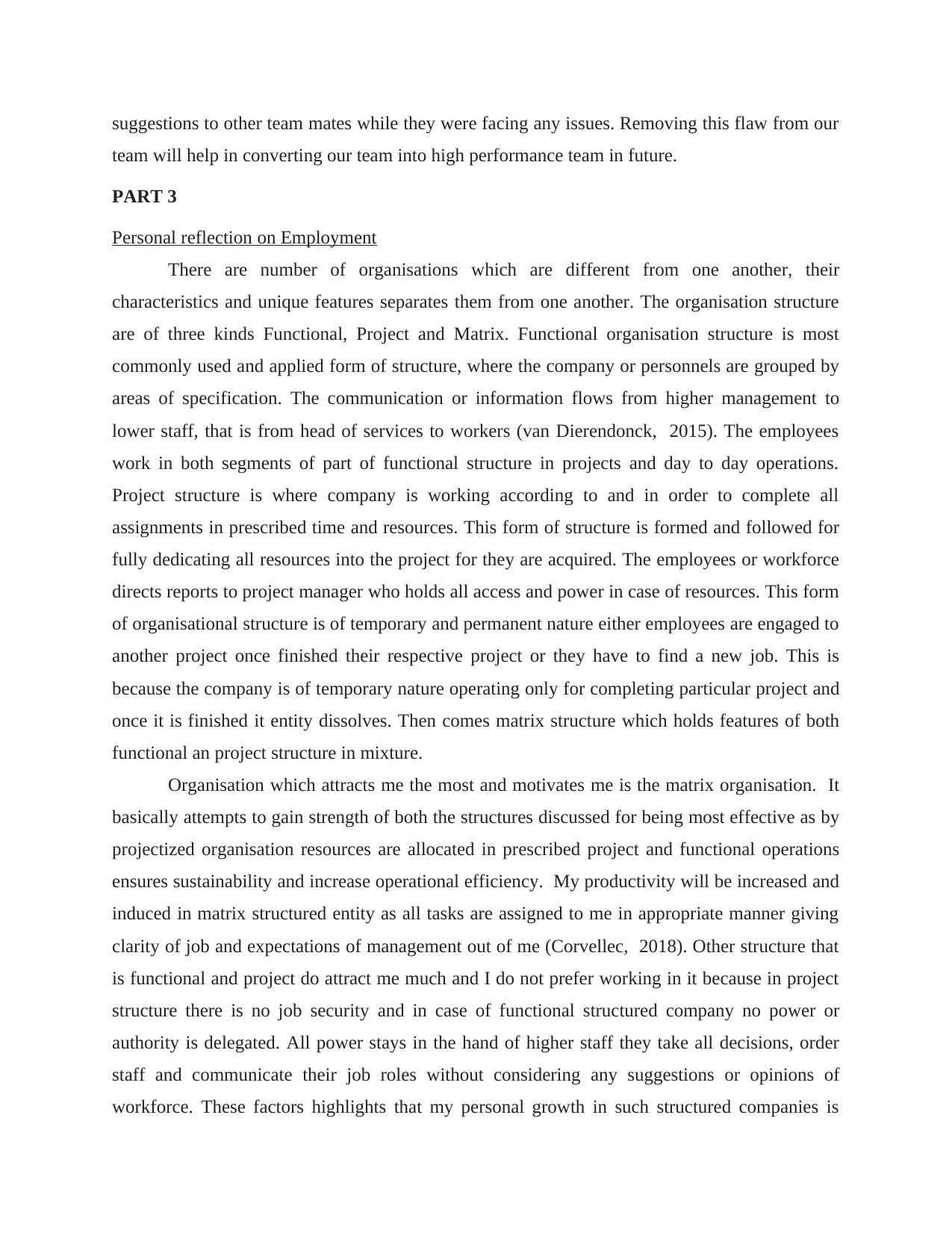
suggestions to other team mates while they were facing any issues. Removing this flaw from our
team will help in converting our team into high performance team in future.
PART 3
Personal reflection on Employment
There are number of organisations which are different from one another, their
characteristics and unique features separates them from one another. The organisation structure
are of three kinds Functional, Project and Matrix. Functional organisation structure is most
commonly used and applied form of structure, where the company or personnels are grouped by
areas of specification. The communication or information flows from higher management to
lower staff, that is from head of services to workers (van Dierendonck, 2015). The employees
work in both segments of part of functional structure in projects and day to day operations.
Project structure is where company is working according to and in order to complete all
assignments in prescribed time and resources. This form of structure is formed and followed for
fully dedicating all resources into the project for they are acquired. The employees or workforce
directs reports to project manager who holds all access and power in case of resources. This form
of organisational structure is of temporary and permanent nature either employees are engaged to
another project once finished their respective project or they have to find a new job. This is
because the company is of temporary nature operating only for completing particular project and
once it is finished it entity dissolves. Then comes matrix structure which holds features of both
functional an project structure in mixture.
Organisation which attracts me the most and motivates me is the matrix organisation. It
basically attempts to gain strength of both the structures discussed for being most effective as by
projectized organisation resources are allocated in prescribed project and functional operations
ensures sustainability and increase operational efficiency. My productivity will be increased and
induced in matrix structured entity as all tasks are assigned to me in appropriate manner giving
clarity of job and expectations of management out of me (Corvellec, 2018). Other structure that
is functional and project do attract me much and I do not prefer working in it because in project
structure there is no job security and in case of functional structured company no power or
authority is delegated. All power stays in the hand of higher staff they take all decisions, order
staff and communicate their job roles without considering any suggestions or opinions of
workforce. These factors highlights that my personal growth in such structured companies is
team will help in converting our team into high performance team in future.
PART 3
Personal reflection on Employment
There are number of organisations which are different from one another, their
characteristics and unique features separates them from one another. The organisation structure
are of three kinds Functional, Project and Matrix. Functional organisation structure is most
commonly used and applied form of structure, where the company or personnels are grouped by
areas of specification. The communication or information flows from higher management to
lower staff, that is from head of services to workers (van Dierendonck, 2015). The employees
work in both segments of part of functional structure in projects and day to day operations.
Project structure is where company is working according to and in order to complete all
assignments in prescribed time and resources. This form of structure is formed and followed for
fully dedicating all resources into the project for they are acquired. The employees or workforce
directs reports to project manager who holds all access and power in case of resources. This form
of organisational structure is of temporary and permanent nature either employees are engaged to
another project once finished their respective project or they have to find a new job. This is
because the company is of temporary nature operating only for completing particular project and
once it is finished it entity dissolves. Then comes matrix structure which holds features of both
functional an project structure in mixture.
Organisation which attracts me the most and motivates me is the matrix organisation. It
basically attempts to gain strength of both the structures discussed for being most effective as by
projectized organisation resources are allocated in prescribed project and functional operations
ensures sustainability and increase operational efficiency. My productivity will be increased and
induced in matrix structured entity as all tasks are assigned to me in appropriate manner giving
clarity of job and expectations of management out of me (Corvellec, 2018). Other structure that
is functional and project do attract me much and I do not prefer working in it because in project
structure there is no job security and in case of functional structured company no power or
authority is delegated. All power stays in the hand of higher staff they take all decisions, order
staff and communicate their job roles without considering any suggestions or opinions of
workforce. These factors highlights that my personal growth in such structured companies is
⊘ This is a preview!⊘
Do you want full access?
Subscribe today to unlock all pages.

Trusted by 1+ million students worldwide
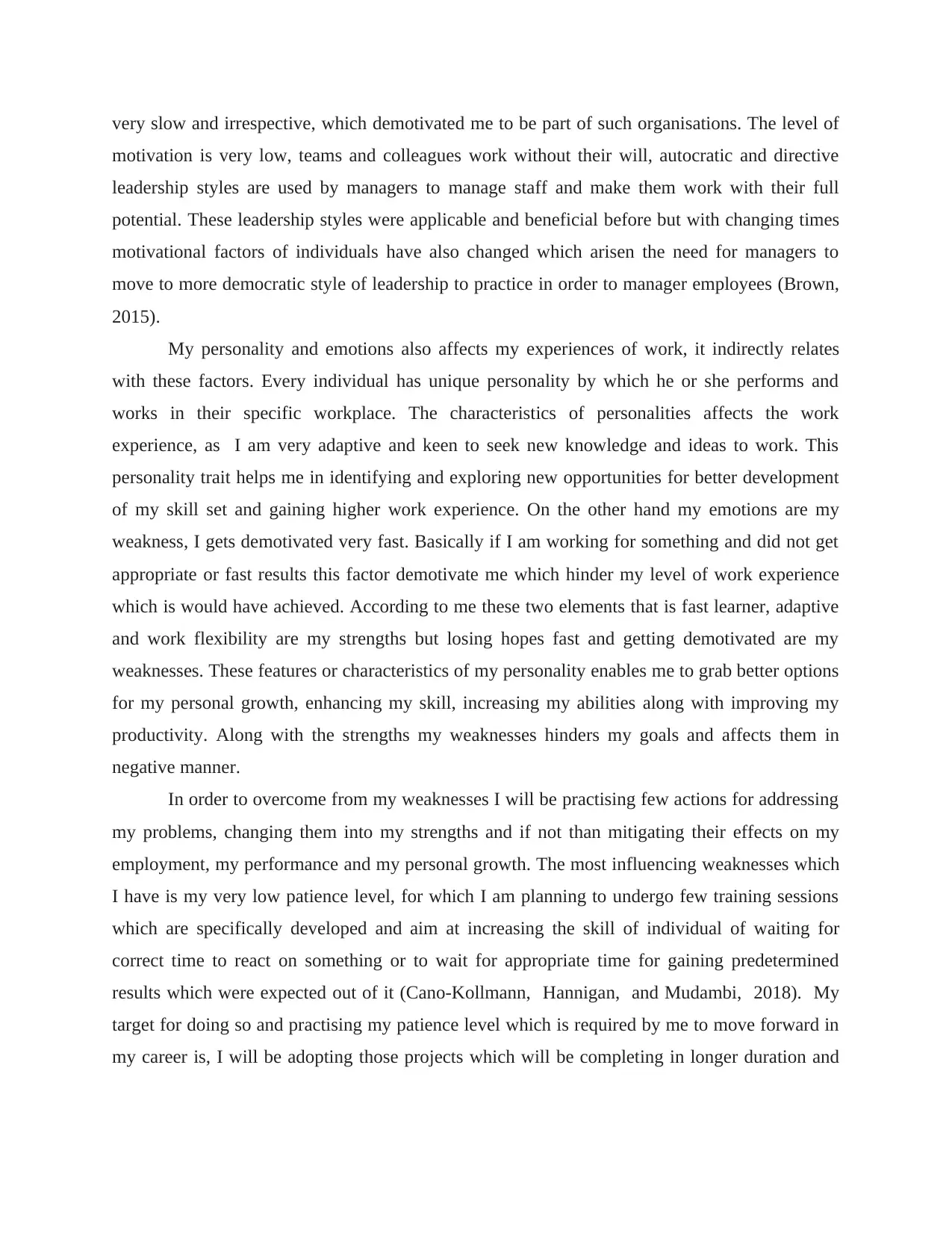
very slow and irrespective, which demotivated me to be part of such organisations. The level of
motivation is very low, teams and colleagues work without their will, autocratic and directive
leadership styles are used by managers to manage staff and make them work with their full
potential. These leadership styles were applicable and beneficial before but with changing times
motivational factors of individuals have also changed which arisen the need for managers to
move to more democratic style of leadership to practice in order to manager employees (Brown,
2015).
My personality and emotions also affects my experiences of work, it indirectly relates
with these factors. Every individual has unique personality by which he or she performs and
works in their specific workplace. The characteristics of personalities affects the work
experience, as I am very adaptive and keen to seek new knowledge and ideas to work. This
personality trait helps me in identifying and exploring new opportunities for better development
of my skill set and gaining higher work experience. On the other hand my emotions are my
weakness, I gets demotivated very fast. Basically if I am working for something and did not get
appropriate or fast results this factor demotivate me which hinder my level of work experience
which is would have achieved. According to me these two elements that is fast learner, adaptive
and work flexibility are my strengths but losing hopes fast and getting demotivated are my
weaknesses. These features or characteristics of my personality enables me to grab better options
for my personal growth, enhancing my skill, increasing my abilities along with improving my
productivity. Along with the strengths my weaknesses hinders my goals and affects them in
negative manner.
In order to overcome from my weaknesses I will be practising few actions for addressing
my problems, changing them into my strengths and if not than mitigating their effects on my
employment, my performance and my personal growth. The most influencing weaknesses which
I have is my very low patience level, for which I am planning to undergo few training sessions
which are specifically developed and aim at increasing the skill of individual of waiting for
correct time to react on something or to wait for appropriate time for gaining predetermined
results which were expected out of it (Cano-Kollmann, Hannigan, and Mudambi, 2018). My
target for doing so and practising my patience level which is required by me to move forward in
my career is, I will be adopting those projects which will be completing in longer duration and
motivation is very low, teams and colleagues work without their will, autocratic and directive
leadership styles are used by managers to manage staff and make them work with their full
potential. These leadership styles were applicable and beneficial before but with changing times
motivational factors of individuals have also changed which arisen the need for managers to
move to more democratic style of leadership to practice in order to manager employees (Brown,
2015).
My personality and emotions also affects my experiences of work, it indirectly relates
with these factors. Every individual has unique personality by which he or she performs and
works in their specific workplace. The characteristics of personalities affects the work
experience, as I am very adaptive and keen to seek new knowledge and ideas to work. This
personality trait helps me in identifying and exploring new opportunities for better development
of my skill set and gaining higher work experience. On the other hand my emotions are my
weakness, I gets demotivated very fast. Basically if I am working for something and did not get
appropriate or fast results this factor demotivate me which hinder my level of work experience
which is would have achieved. According to me these two elements that is fast learner, adaptive
and work flexibility are my strengths but losing hopes fast and getting demotivated are my
weaknesses. These features or characteristics of my personality enables me to grab better options
for my personal growth, enhancing my skill, increasing my abilities along with improving my
productivity. Along with the strengths my weaknesses hinders my goals and affects them in
negative manner.
In order to overcome from my weaknesses I will be practising few actions for addressing
my problems, changing them into my strengths and if not than mitigating their effects on my
employment, my performance and my personal growth. The most influencing weaknesses which
I have is my very low patience level, for which I am planning to undergo few training sessions
which are specifically developed and aim at increasing the skill of individual of waiting for
correct time to react on something or to wait for appropriate time for gaining predetermined
results which were expected out of it (Cano-Kollmann, Hannigan, and Mudambi, 2018). My
target for doing so and practising my patience level which is required by me to move forward in
my career is, I will be adopting those projects which will be completing in longer duration and
Paraphrase This Document
Need a fresh take? Get an instant paraphrase of this document with our AI Paraphraser
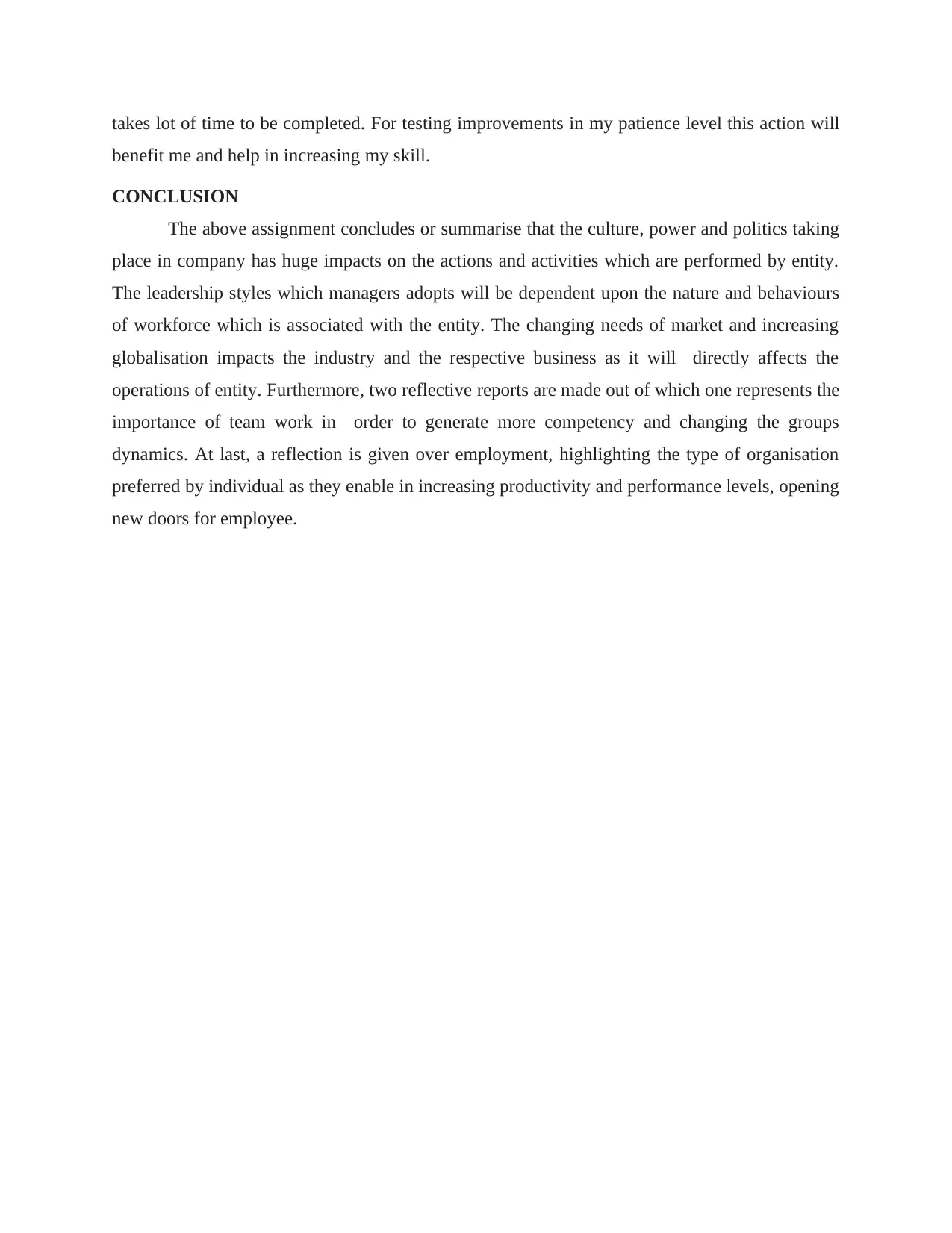
takes lot of time to be completed. For testing improvements in my patience level this action will
benefit me and help in increasing my skill.
CONCLUSION
The above assignment concludes or summarise that the culture, power and politics taking
place in company has huge impacts on the actions and activities which are performed by entity.
The leadership styles which managers adopts will be dependent upon the nature and behaviours
of workforce which is associated with the entity. The changing needs of market and increasing
globalisation impacts the industry and the respective business as it will directly affects the
operations of entity. Furthermore, two reflective reports are made out of which one represents the
importance of team work in order to generate more competency and changing the groups
dynamics. At last, a reflection is given over employment, highlighting the type of organisation
preferred by individual as they enable in increasing productivity and performance levels, opening
new doors for employee.
benefit me and help in increasing my skill.
CONCLUSION
The above assignment concludes or summarise that the culture, power and politics taking
place in company has huge impacts on the actions and activities which are performed by entity.
The leadership styles which managers adopts will be dependent upon the nature and behaviours
of workforce which is associated with the entity. The changing needs of market and increasing
globalisation impacts the industry and the respective business as it will directly affects the
operations of entity. Furthermore, two reflective reports are made out of which one represents the
importance of team work in order to generate more competency and changing the groups
dynamics. At last, a reflection is given over employment, highlighting the type of organisation
preferred by individual as they enable in increasing productivity and performance levels, opening
new doors for employee.
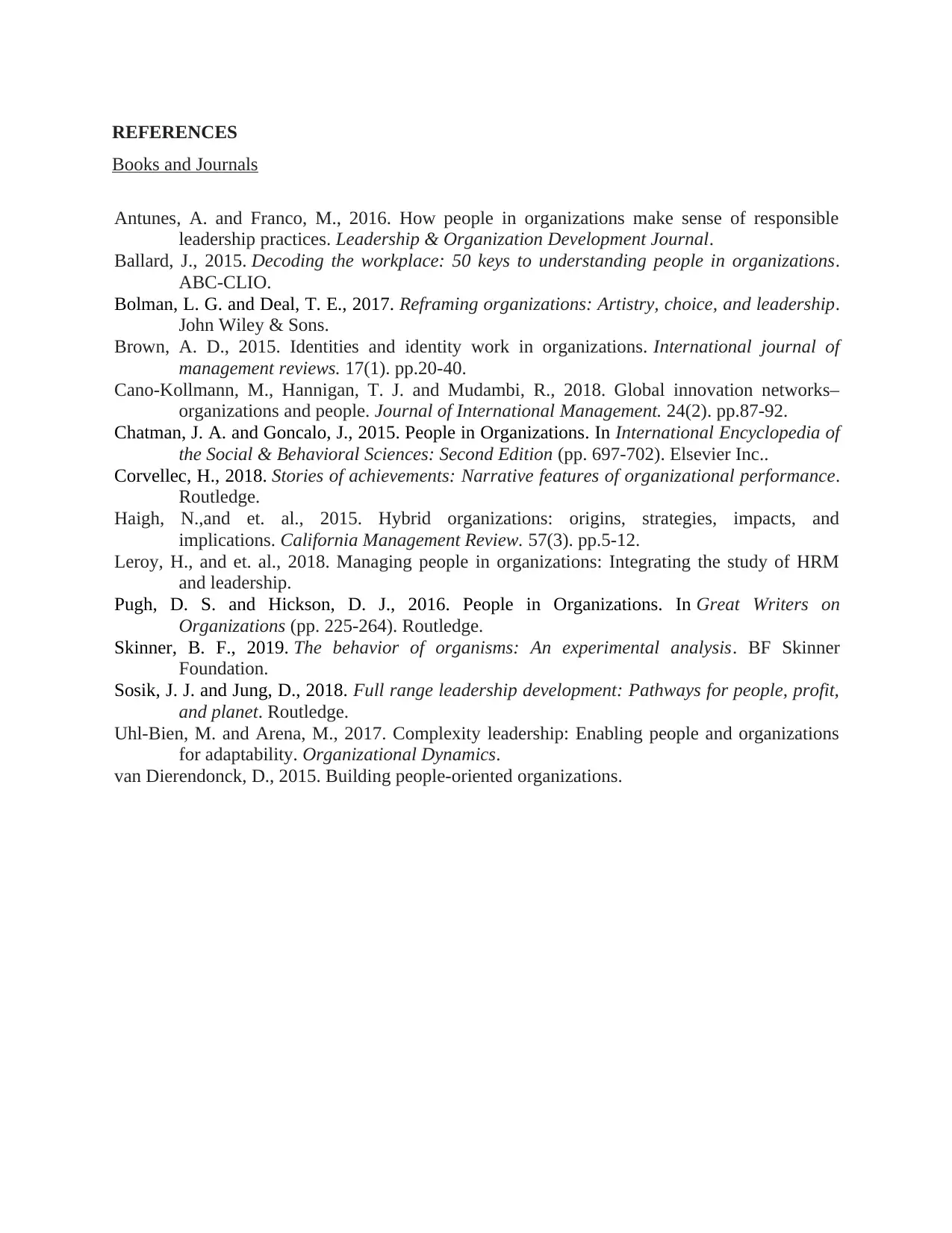
REFERENCES
Books and Journals
Antunes, A. and Franco, M., 2016. How people in organizations make sense of responsible
leadership practices. Leadership & Organization Development Journal.
Ballard, J., 2015. Decoding the workplace: 50 keys to understanding people in organizations.
ABC-CLIO.
Bolman, L. G. and Deal, T. E., 2017. Reframing organizations: Artistry, choice, and leadership.
John Wiley & Sons.
Brown, A. D., 2015. Identities and identity work in organizations. International journal of
management reviews. 17(1). pp.20-40.
Cano-Kollmann, M., Hannigan, T. J. and Mudambi, R., 2018. Global innovation networks–
organizations and people. Journal of International Management. 24(2). pp.87-92.
Chatman, J. A. and Goncalo, J., 2015. People in Organizations. In International Encyclopedia of
the Social & Behavioral Sciences: Second Edition (pp. 697-702). Elsevier Inc..
Corvellec, H., 2018. Stories of achievements: Narrative features of organizational performance.
Routledge.
Haigh, N.,and et. al., 2015. Hybrid organizations: origins, strategies, impacts, and
implications. California Management Review. 57(3). pp.5-12.
Leroy, H., and et. al., 2018. Managing people in organizations: Integrating the study of HRM
and leadership.
Pugh, D. S. and Hickson, D. J., 2016. People in Organizations. In Great Writers on
Organizations (pp. 225-264). Routledge.
Skinner, B. F., 2019. The behavior of organisms: An experimental analysis. BF Skinner
Foundation.
Sosik, J. J. and Jung, D., 2018. Full range leadership development: Pathways for people, profit,
and planet. Routledge.
Uhl-Bien, M. and Arena, M., 2017. Complexity leadership: Enabling people and organizations
for adaptability. Organizational Dynamics.
van Dierendonck, D., 2015. Building people-oriented organizations.
Books and Journals
Antunes, A. and Franco, M., 2016. How people in organizations make sense of responsible
leadership practices. Leadership & Organization Development Journal.
Ballard, J., 2015. Decoding the workplace: 50 keys to understanding people in organizations.
ABC-CLIO.
Bolman, L. G. and Deal, T. E., 2017. Reframing organizations: Artistry, choice, and leadership.
John Wiley & Sons.
Brown, A. D., 2015. Identities and identity work in organizations. International journal of
management reviews. 17(1). pp.20-40.
Cano-Kollmann, M., Hannigan, T. J. and Mudambi, R., 2018. Global innovation networks–
organizations and people. Journal of International Management. 24(2). pp.87-92.
Chatman, J. A. and Goncalo, J., 2015. People in Organizations. In International Encyclopedia of
the Social & Behavioral Sciences: Second Edition (pp. 697-702). Elsevier Inc..
Corvellec, H., 2018. Stories of achievements: Narrative features of organizational performance.
Routledge.
Haigh, N.,and et. al., 2015. Hybrid organizations: origins, strategies, impacts, and
implications. California Management Review. 57(3). pp.5-12.
Leroy, H., and et. al., 2018. Managing people in organizations: Integrating the study of HRM
and leadership.
Pugh, D. S. and Hickson, D. J., 2016. People in Organizations. In Great Writers on
Organizations (pp. 225-264). Routledge.
Skinner, B. F., 2019. The behavior of organisms: An experimental analysis. BF Skinner
Foundation.
Sosik, J. J. and Jung, D., 2018. Full range leadership development: Pathways for people, profit,
and planet. Routledge.
Uhl-Bien, M. and Arena, M., 2017. Complexity leadership: Enabling people and organizations
for adaptability. Organizational Dynamics.
van Dierendonck, D., 2015. Building people-oriented organizations.
⊘ This is a preview!⊘
Do you want full access?
Subscribe today to unlock all pages.

Trusted by 1+ million students worldwide
1 out of 12
Related Documents
Your All-in-One AI-Powered Toolkit for Academic Success.
+13062052269
info@desklib.com
Available 24*7 on WhatsApp / Email
![[object Object]](/_next/static/media/star-bottom.7253800d.svg)
Unlock your academic potential
Copyright © 2020–2025 A2Z Services. All Rights Reserved. Developed and managed by ZUCOL.





